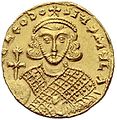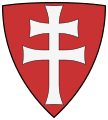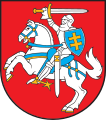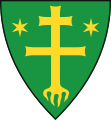Patriarchal cross
This article needs additional citations for verification. (September 2014) |

The Patriarchal cross is a variant of the Christian cross, the religious symbol of Christianity, and is also known as the Cross of Lorraine. Similar to the familiar Latin cross, the patriarchal cross possesses a smaller crossbar placed above the main one so that both crossbars are near the top. Sometimes the patriarchal cross has a short, slanted crosspiece near its foot (Russian Orthodox cross). This slanted, lower crosspiece often appears in Byzantine Greek and Eastern European iconography, as well as in other Eastern Orthodox churches[citation needed]. In most renditions of the Cross of Lorraine, the horizontal bars are "graded" with the upper bar being the shorter, though variations with the bars of equal length are also seen.
Imagery
The top beam represents the plaque bearing the inscription "
Many symbolic interpretations of the double-cross have been put forth. One of them says that the first horizontal line symbolized the secular power and the other horizontal line the ecclesiastic power of
Other variations
The Russian Orthodox cross can be considered a modified version of the Patriarchal cross, having two smaller crossbeams, one at the top and one near the bottom, in addition to the longer crossbeam. One suggestion is the lower crossbeam represents the footrest (suppedaneum) to which the feet of Jesus were nailed. In some earlier representations (and still currently in the Greek Church) the crossbar near the bottom is straight or slanted upwards. In later Slavic and other traditions, it came to be depicted as slanted, with the side to the viewer's left usually being higher.
One tradition says that this comes from the idea that as
-
Roman Catholic metropolitan archbishop's coat of arms (version with pallium
-
The Russian cross, with slanted cross-bar (suppedaneum)
-
A variation of the Russian cross, so called "Calvary cross"
-
Archangels' cross
-
Archangels' cross variant
Byzantine Empire
The Patriarchal cross first regularly appeared on the coinage of the
-
A solidus of Emperor Theodosius III (r. 715–717) holding a globus cruciger surmounted by a patriarchal cross.
-
ANikephoros II (r. 963–969) and Basil II(r. 976–1025) depicted "wielding the sceptre" (patriarchal cross).
-
A miliaresion of Emperor Michael VII Doukas (r. 1071–1078) depicting a middle Byzantine cross-crosslet variant of the patriarchal cross.
-
A fresco of Serbian Emperor Stefan Dušan holding the patriarchal cross in the manner of a Byzantine Emperor.
Hungary
The two-barred cross has been one of the main elements in the coat of arms of Hungary at least since 1190. It appeared during the reign of King Béla III,[3] who was raised in the Byzantine court. He was for a time heir to the throne of the Byzantine Empire and betrothed to the emperor's daughter. When the emperor's wife gave birth to a son, the emperor dissolved his daughter's betrothal to Béla and removed Béla's title of despotes. Soon after Béla left Constantinople when he inherited the Hungarian throne in 1172. The cross started appearing floating in the coat of arms and on the coins from this era. During the middle ages, the two-barred cross became associated with the Árpád dynasty and the Kingdom of Hungary along with the Árpád stripes. The symbol found its way to Western Europe through Hungary, because René the Good, who was related to the House Anjou of Hungary, laid claim to four kingdoms, including Hungary. He placed the symbol on his flags before the battle of Nancy.[4] He won the battle and regained his lost Duchy of Lorraine. Thus the symbol became known in Western-Europe as the Cross of Lorraine.
-
Saint Stephen, the first King of Hungary (1000–1038).
-
Béla III
-
Hősök tere, Budapest, Hungary
-
The globus cruciger of Hungary (right) is unique in having a patriarchal cross instead of a simple cross
-
Coat of arms of Pest County, Hungary
Lithuania and Belarus
Another form of the cross was used by the Jagiellonian dynasty. This cross now features on the coat of arms of Lithuania, where it appears on the shield of the Vytis. It is also the badge of the Lithuanian Air Force and forms the country's highest award for bravery, the Order of the Cross of Vytis. The Jagiellonian cross is also used on the coat of arms and flags of every Lithuanian county.
The Patriarchal Cross appears on the Vytis (Pahonia), used at various times as the coat of arms of Lithuania for centuries and of Belarus for four years.
-
Coat of arms of King Władysław II Jagiełło
-
The coat of arms of Lithuania, with the patriarchal cross on the knight's shield
-
The badge of the Lithuanian Air Force
Great Moravia
The Byzantine Christianization came to the Morava Empire in the year 863, provided at the request of Rastislav sent Byzantine Emperor Michael III.[5] The symbol often referred to as the patriarchal cross, appeared in the Byzantine Empire in large numbers in the 10th century. For a long time, it was thought to have been given to Saint Stephen by the pope as the symbol of the apostolic Kingdom of Hungary.
Russia
During 1577–1625 the Russian use of the cross was between the heads of the double-headed eagle in the coat of arms of Russia.
Slovakia
The territory of present-day Slovakia was an integral part of the Kingdom of Hungary from the 10th century until the Treaty of Trianon in 1920. Many of its cities gained privileges and coats of arms from the Hungarian kings, often containing the kings' own coat of arms.
-
Coat of arms of the city of Nitra, Slovakia
-
Coat of arms of the city of Skalica, Slovakia
-
Coat of arms of the city of Levoča, Slovakia
-
Coat of arms of the city of Žilina, Slovakia
-
Coat of arms of the city of Zvolen, Slovakia
-
Flag of theHlinka's Slovak People's Party1938 to 1945
Typefaces
Unicode defines the character ☦ (Russian cross) and ☨ (Cross of Lorraine) in the Miscellaneous Symbols range at code point U+2626 and U+2628 respectively.
See also
- Papal cross
- Lorraine cross
- Two-barred cross
References
- ^ Breckenridge, James (1959). The Numismatic Iconography of Justinian II. The American Numismatic Society. p. 23.
- ISBN 0900652713.
- ^ Engel 2001, p. 86.
- ^ Monter 2007, pp. 22–23.
- ^ Spiesz et al. 2006, p. 22.
Sources
- Engel, Pál (2001). The Realm of St Stephen: A History of Medieval Hungary, 895–1526. I.B. Tauris Publishers. ISBN 1-86064-061-3.
- Monter, William (2007). A Bewitched Duchy: Lorraine and its Dukes, 1477–1736. Librairie Droz. ISBN 978-2-600-01165-5.


























